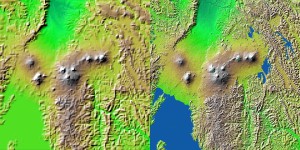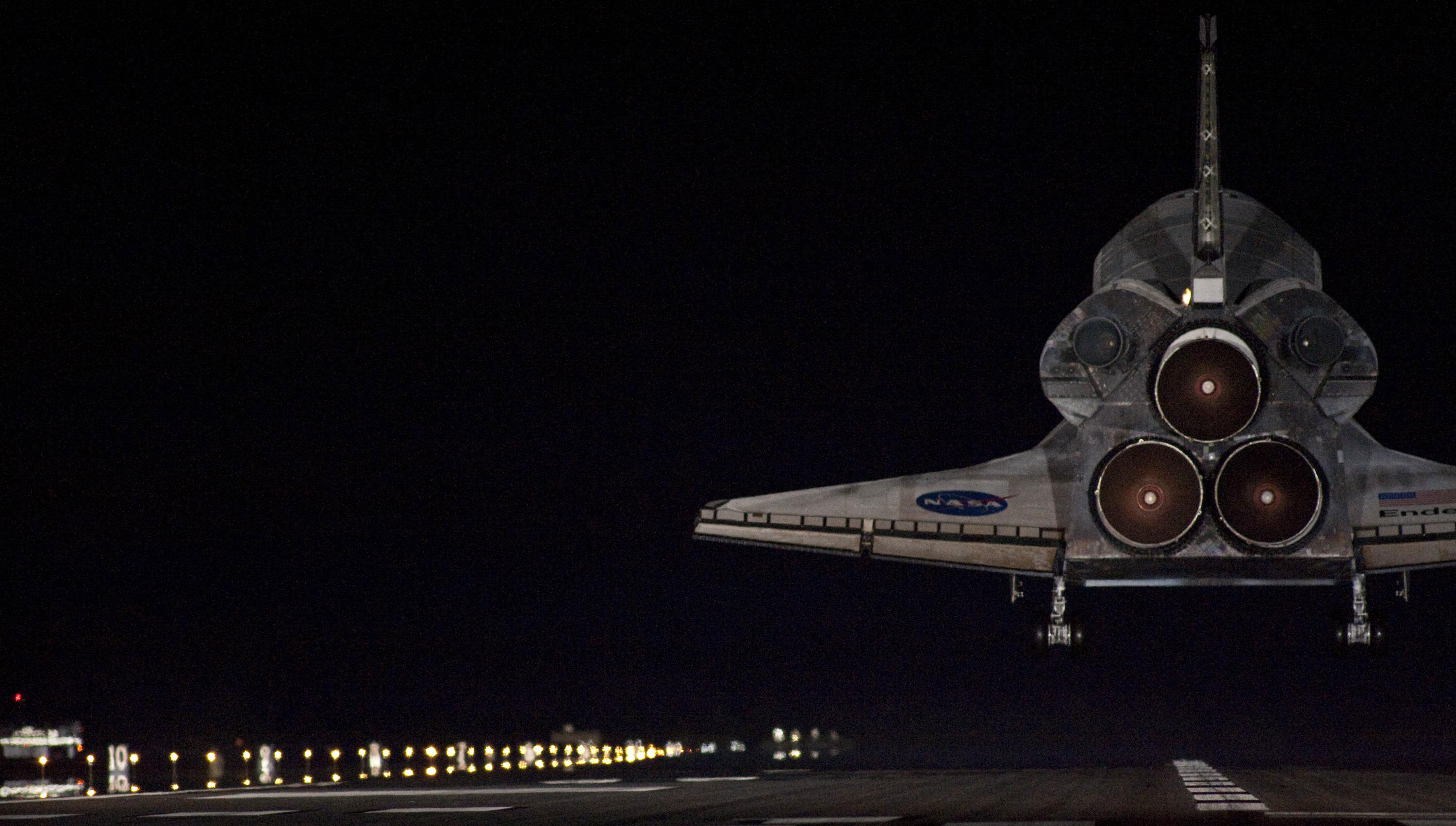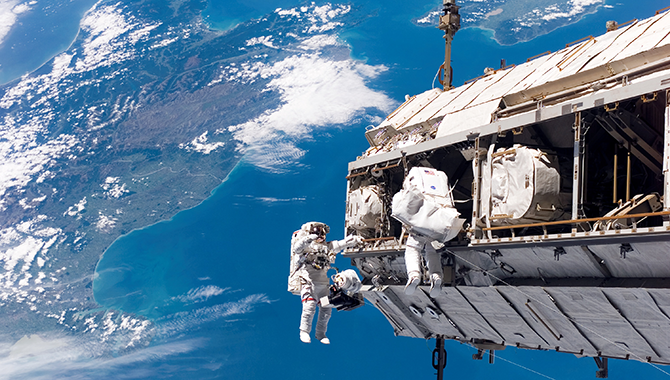
An antenna at the end of the 200-foot mast extending from the Endeavour facilitated 24-hour mapping of the globe. The mast was the longest rigid structure ever deployed from the shuttle.
Photo Credit: NASA
Fifteen years ago this month, Endeavour (STS-99) overcame launch delays and on-orbit challenges to capture Earth’s topography in unprecedented detail.
Before the 21st century, topographical maps of many regions across the globe were incomplete or unreliable. The reasons for this were varied. In some cases, it was due to lack of access to a particular area; in others, it occurred because differences in data-gathering methods rendered maps incompatible or unusable. This lack of consistency and reliability hindered critical activities such as flood management, city planning, aircraft navigation, cell tower placement, military operations, and scientific study, including monitoring glacier movements, earthquakes, and volcanoes.
To overcome the problem, a single, highly reliable source for topographical data was needed. The solution was the Shuttle Radar Topography Mission (SRTM): an international initiative that employed C-band and X-band interferometric synthetic aperture radars (IFSARs) to capture high-resolution digital images of more than 80% of the Earth’s land mass, an area that houses roughly 95% of the world’s population. NASA partnered with the Department of Defense’s National Geospatial-Intelligence Agency (NGA, known then as the National Imagery and Mapping Agency (NIMA)) as well as the German and Italian space agencies to develop the system. The goal of SRTM was to map the area between 60 degrees north and 56 degrees south latitude, taking nearly one trillion measurements in the process. These measurements would be accurate to within 50 feet, providing the most precise and uniform map to date.
The SRTM worked by bouncing radar beams off of two antennae: one in the shuttle’s payload bay and one at the end of a nearly 200-foot mast extending from the orbiter. Differences between the two images provided the information needed to calculate the topography of the ground below. Radar was particularly suited to the task because it could capture images through darkness and cloud cover, allowing the SRTM to operate 24 hours a day.
Despite the mission’s importance, STS-99 took months to get off the ground. Originally planned for September 1999, the launch was delayed multiple times: faulty wiring concerns grounded the spacecraft in September and October, a conflicting shuttle mission to service the Hubble Space Telescope pushed it back in November, and problems with the number 2 enhanced master events controller scrubbed a launch in January. It wasn’t until February 11, 2000, that Endeavour launched from Cape Canaveral to reach its operating altitude of 150 statute miles.

Images depicting parts of Congo, Rwanda, and Uganda are shown side by side. The image on the left, from the U.S. Geological Survey’s GTOPO30, lacks clarity. In contrast, the image on the right, from the SRTM, features far greater detail.Image Credit: NASA/JPL/NIMA
Lower than most shuttle missions, that altitude was crucial to accurately map the planet. But the lower orbit incurred some drag from the upper edges of Earth’s atmosphere, slowing the spacecraft just enough to make it difficult to stay at the desired altitude. As a result, the crew had to perform a daily “flycast” maneuver: an action designed to keep the shuttle at the correct height relative to the ground while reducing strain on the mast as the spacecraft moved. So while Endeavour flew tail first with its 200-foot mast protruding down toward the earth during mapping, it shifted to a nose-first orientation with the mast extended above it for the maneuver. The crew then briefly activated the spacecraft’s reaction control system, causing the mast to move backward before snapping gently forward. As the mast reached its apex, the crew applied a stronger thrust that halted the mast’s movement while increasing the orbiter’s speed. The shuttle could then return to its tail-first/mast-down position to resume mapping at the appropriate altitude.
That mast—the longest rigid structure ever deployed by the shuttle—was an integral part of the mission’s potential for success: it housed the second antenna, facilitating the dual image capture that would enable topographical calculations. But it caused problems from the start. On day 2, the crew realized that the mast’s damping system, used to protect it during shuttle maneuvers, didn’t work. On day 3, they noted that the small nitrogen jet on the antenna at the end of the mast wasn’t functioning. The problem didn’t affect the mapping activities but did require the orbiter to burn more propellant than expected in order to keep the mast at the proper attitude. Ultimately, the two issues proved manageable: the mast survived the shuttle maneuvers without incident, and controllers figured out other ways to conserve propellant in order to continue the mission.
The biggest problem with the mast was not revealed until the mapping activities were complete. By day 10, the crew had spent 222 hours and 23 minutes mapping the earth below. Nearly 100% of the planned area had been imaged, with about 95% of it covered at least twice. The collected data filled 332 high-density tapes—the equivalent of 20,000 CDs. It took scientists more than a year to convert all of the raw data into topographic maps.
Following a final sweep of Australia, the SRTM was deemed a success. The next day, the crew prepared to return to Earth. They retracted the mast into its storage canister, where it would remain until after landing. But the canister’s three latches failed to lock. Consulting with ground operations, the crew determined that the cold temperatures of space had diminished the flexibility of the mast, preventing it from collapsing the final inch or two needed to lock the canister. They tried warming the canister and increasing the thrust of the canister motors. Two and a half hours later, a final attempt forced the latches to lock at last and Endeavour was cleared for the trip home, bringing to an end the first human spaceflight of the 21st century.
The data from SRTM engaged scientists around the globe and confirmed the value of space-based radar in achieving a better understanding of the planet. Initially, only limited data for areas outside of the U.S. were released to the public. But in September 2014, full high-resolution images for the entire globe were scheduled for public release in 2015.
The SRTM was managed by the Jet Propulsion Laboratory (JPL) for the NGA and NASA’s Earth Sciences program.









